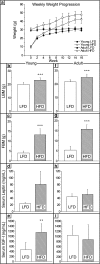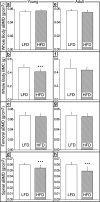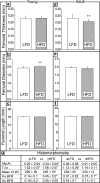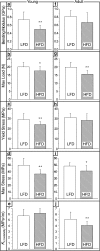Changes in cortical bone response to high-fat diet from adolescence to adulthood in mice
- PMID: 20941479
- PMCID: PMC3132390
- DOI: 10.1007/s00198-010-1432-x
Changes in cortical bone response to high-fat diet from adolescence to adulthood in mice
Abstract
Diabetic obesity is associated with increased fracture risk in adults and adolescents. We find in both adolescent and adult mice dramatically inferior mechanical properties and structural quality of cortical bone, in agreement with the human fracture data, although some aspects of the response to obesity appear to differ by age.
Introduction: The association of obesity with bone is complex and varies with age. Diabetic obese adolescents and adult humans have increased fracture risk. Prior studies have shown reduced mechanical properties as a result of high-fat diet (HFD) but do not fully address size-independent mechanical properties or structural quality, which are important to understand material behavior.
Methods: Cortical bone from femurs and tibiae from two age groups of C57BL/6 mice fed either HFD or low-fat diet (LFD) were evaluated for structural and bone turnover changes (SEM and histomorphometry) and tested for bending strength, bending stiffness, and fracture toughness. Leptin, IGF-I, and non-enzymatic glycation measurements were also collected.
Results: In both young and adult mice fed on HFD, femoral strength, stiffness, and toughness are all dramatically lower than controls. Inferior lamellar and osteocyte alignment also point to reduced structural quality in both age groups. Bone size was largely unaffected by HFD, although there was a shift from increasing bone size in obese adolescents to decreasing in adults. IGF-I levels were lower in young obese mice only.
Conclusions: While the response to obesity of murine cortical bone mass, bone formation, and hormonal changes appear to differ by age, the bone mechanical properties for young and adult groups are similar. In agreement with human fracture trends, adult mice may be similarly susceptible to bone fracture to the young group, although cortical bone in the two age groups responds to diabetic obesity differently.
Figures






